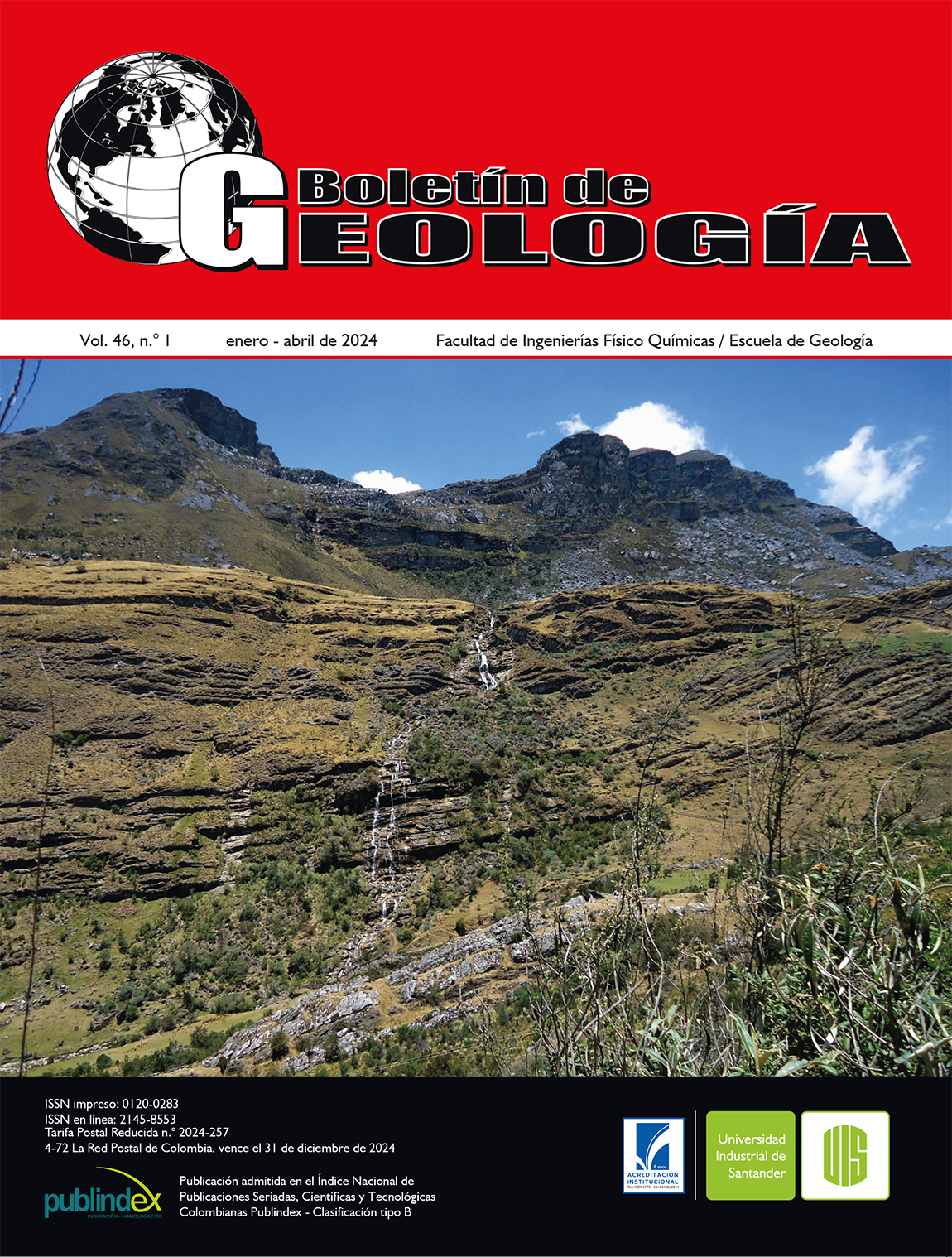Identificación de cortes en sección delgada de las especies Clavihedbergella simplex y Clavihedbergella moremani presentes en rocas Cretácicas provenientes de la parte central del Valle Medio del Magdalena, Colombia
Publicado 2024-03-08
Palabras clave
- Fósiles calcáreos,
- Foraminíferos,
- Género Clavihedbergella,
- Descripción taxonómica,
- Cenomaniano
- Turoniano ...Más
Cómo citar
Derechos de autor 2024 Boletín de Geología

Esta obra está bajo una licencia internacional Creative Commons Atribución 4.0.
Altmetrics
Resumen
El estudio de foraminíferos planctónicos usando secciones delgadas es relativamente reciente y en el caso de las especies Clavihedbergella simplex y Clavihedbergella moremani es un método que facilita su observación e identificación, más aún en rocas Cretácicas colombianas donde el método de preparación tradicional con peróxido no es efectivo. Este estudio hace una descripción taxonómica de dichas especies a partir de ejemplares en secciones delgadas e identifica sus respectivas ocurrencias a lo largo de rocas Cretácicas en un pozo ubicado en la parte central del Valle Medio del Magdalena, Colombia. Las directrices presentadas en este estudio validan la utilidad de este método de investigación y facilitan la identificación de estas dos especies en sección delgada.
Descargas
Referencias
- Arz, J.A.; Molina E. (2002). Bioestratigrafía y cronoestratigrafía con foraminíferos planctónicos del Campaniense superior y Maastrichtiense de latitudes templadas y subtropicales (España, Francia y Tunicia). Neues Jahrbuch für Geologie und Paläontologie, Abhandlungen, 224(2), 161-195. http://doi.org/10.1127/nigpa/224/2002/161
- Banner, F.T.; Blow, W.H. (1959). The classification and stratigraphical distribution of the Globigerinaceae. Palaeontology, 2(1), 1-27.
- Bolli, H. (1945). Zur Stratigraphie der Oberen Kreide in den höheren helvetischen Decken. Eclogae Geologic Helvetiae, 37, 217-331. http://doi.org/10.5169/seals160503
- Bolli, H.; Saunders, J.; Perch-Nielsen, K. (1989). Plankton Stratigraphy. Cambridge University Press.
- Caron, M. (1978). Cretaceous Planktonic Foraminifers from DSDP Leg 40, Southeastern Atlantic Ocean. Initial Reports of the Deep Sea Drilling Project, 40. https://doi.org/10.2973/dsdp.proc.40.114.1978
- Coccioni, H.; Premoli-Silva, I. (2015). Revised Upper Albian-Maastrichtian planktonic foraminiferal biostratigraphy and magneto-stratigraphy of the classical Tethyan Gubbio section (Italy). Newsletters on Stratigraphy, 48(1), 47-90. https://doi.org/10.1127/nos/2015/0055
- Cushman, J.A. (1931). Hastigerinella and other interesting foraminifera from the Upper Cretaceous of Texas. Contributions from the Cushman Laboratory for Foraminiferal Research, 7(4), 83-90.
- Eicher, D.L.; Worstell, P. (1970). Lunatriella, a Cretaceous Heterohelicid Foraminifer from the Western Interior of the United States. Micropaleontology, 16(1), 117-121. https://doi.org/10.2307/1484852
- Jaff, R.B.N. (2021). A designed model for identifications of Dicarinella concavata (Brotzen, 1934) and Dicarinella asymetrica (Sigal, 1952) planktic foraminifer species under thin sections: an example from the Kurdistan region, NE Iraq. Jordan Journal of Earth and Environmental Sciences, 12(2), 154-162.
- Jones, R.W. (2014). Foraminifera and their Applications. Cambridge University Press. https://doi.org/10.1017/CBO9781139567619
- Kalanat, B.; Vaziri-Moghaddam, H.; Bijani, S. (2021). Depositional history of the uppermost Albian–Turonian Sarvak Formation in the Izeh Zone (SW Iran). International Journal of Earth Sciences, 110(1), 305-330. https://doi.org/10.1007/s00531-020-01954-1
- Khan, S.; Kroon, D.; Ahmad, S.; Ali, A.; Wadood, B.; Rahman, A. (2021). Planktonic foraminiferal biostratigraphy of the Cretaceous strata, Indus Basin, Pakistan, Eastern Tethys: implications for oceanic anoxic events. Australian Journal of Earth Sciences, 68(8), 1162-1178. https://doi.org/10.1080/08120099.2021.1913225
- Kopaevich, L.F.; Gorbachik T.N. (2017). Shell morphology of cretaceous planktonic foraminifers as a mean for paleoenvironment reconstructions. Paleontological Journal, 51(1), 1-12. https://doi.org/10.1134/S0031030117010075
- Leckie, R.M. (1984). Mid-Cretaceous planktonic foraminiferal biostratigraphy off central Morocco, Deep Sea Drilling Project Leg 79, Sites 545 and 547. Initial Reports Deep Sea Drilling Project, 79, 579-620. https://doi.org/10.2973/dsdp.proc.79.122.1984
- Loeblich, A.R.; Tappan, H. (1961). Cretaceous planktonic foraminifera: Part I Cenomanian. Micropaleontology, 7(3), 257-304. https://doi.org/10.2307/1484364
- Miles, G.A.; Orr, W.N. (1980). Planktonic foraminifers from the Bermuda Rise, deep sea drilling project Legs 51, 52, and 53. Initial Reports of the Deep Sea Drilling Project, 51, 52-53. https://doi.org/10.2973/dsdp.proc.515253.114.1980
- Monteiro, F.M.; Pancost, R.D; Ridgwell, A.; Donadieu, Y. (2012). Nutrients as the dominant control on the spread of anoxia and euxinia across the Cenomanian-Turonian oceanic anoxic event (OAE2): Model-data comparison. Paleoceanography and Paleoclimatology, 27(4), PA4209. http://doi.org/10.1029/2012PA002351
- Morrow, A.L. (1934). Foraminifera and ostracoda from the Upper Cretaceous of Kansas. Journal of Paleontology, 8(2), 186-205.
- Odin G.S.; Lamaurelle M.A. (2001). The global Campanian-Maastrichtian stage boundary. Episodes Journal of International Geoscience, 24(4), 229-238. https://doi.org/10.18814/epiiugs/2001/v24i4/002
- Pessagno, E.A. (1967). Upper Cretaceous planktonic foraminifera from the western Gulf Coastal Plain. Palaeontographica Americana, 5(37), 245-445.
- Premoli-Silva, I.; Bolli, H.M. (1973). Late Cretaceous to Eocene planktonic foraminifera and stratigraphy of Leg 15 sites in the Caribbean Sea. Initial reports of Deep Sea Drilling Project, 15, 449-547. https://doi.org/10.2973/dsdp.proc.15.111.1973
- Premoli-Silva, I.; Verga, D. (2004). Practical manual of Cretaceous planktonic foraminifera. International School on Planktonic foraminifera, 3º Course: Cretaceous.
- Premoli-Silva, I.; Verga, D. (2011). Practical manual of Cretaceous planktonic foraminifera. International School on Planktonic foraminifera, 3º Course: Cretaceous.
- Renz, O. (1936). Stratigraphische und mikropalaeontologische untersuchung der Scaglia (Obere Kreide-Tertiär) im zentralen Apennin. Eclogae Geologicae Helvetiae, 29(1), 1-149. https://doi.org/10.5169/seals-159606
- Robaszynski, F.; Caron, M.; Gonzalez-Donoso, J.M.; Wonders, A.A.H. (1984). Atlas of Late Cretaceous globotruncanids. Revue de Micropaléontologie, 26(3-4), 145-305.
- Sliter, W.V. (1989). Biostratigraphic zonation for Cretaceous planktonic foraminifers examined in thin section. Journal of Foraminiferal Research, 19(1), 1-19. https://doi.org/10.2113/gsjfr.19.1.1
- Sliter, W.V. (1999). Cretaceous planktic foraminiferal biostratigraphy of the Calera Limestone, northern California, USA. Journal of Foraminiferal Research, 29(4), 318-339.
- Sýkora, M.; Ozvoldova, L.; Boorová, D. (1997). Turonian silicified sediments in the Czorsztyn Succession of the Pieniny Klippen belt (western Carpathians, Slovakia). Geologica Carpathica- Bratislava, 48(4), 243-261.
- Villamil, T.; Arango, C.; Hay W.W. (1999). Plate tectonic paleoceanographic hypothesis for Cretaceous source rocks and cherts of northern South America. AAPG Bulletin, 5. https://doi.org/10.1130/0-8137-2332-9.191
- Young, J.R.; Wade, B.S.; Huber B.T. (2017) pforams@ mikrotax website. http://www.mikrotax.org/pforams

